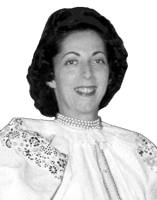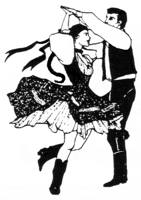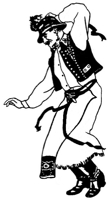
|
The Society of Folk Dance Historians (SFDH)
Csárdás and Verbunk
[
Home |
About |
Encyclopedia | CLICK AN IMAGE TO ENLARGE |

|
CSÁRDÁS
 Hungarian folk dance culture is extremely varied, comprising many distinctive types, such as those of the various crafts, children's dances, dances related to folk customs, et cetera.
Hungarian folk dance culture is extremely varied, comprising many distinctive types, such as those of the various crafts, children's dances, dances related to folk customs, et cetera.
It may surprise the Reader to learn that there is more than one Csárdás – for often all Hungarian folk dances are loosely lumped under this name abroad. We should note, however, that the usual sort of Csárdás has little to do with original Hungarian folk motifs. So, to facilitate a grasp of key stylistic elements, I wish to point out the following:
Csárdás is a generic term comprising diverse types of the original Hungarian folk dance. Actually, all of them are called csárdás, but are found in contrasting ethnic areas. Moreover, there is usually a descriptive prefix, for instance, Rugós Csárdás, Rezgős Csárdás, Kemény Csárdás, etc., indicating that, despite the common name, they differ in structure and motif.
For a long time most Hungarians, and naturally foreigners too, considered these dances "ancient" though they are scarcely a hundred years old. Their origin is linked to Hungary's struggle to shake off the tyrannical Hapsburgs of Austria. From early in the last century, political and economic oppression was met by a surge of national feeling that permeated all ranks of Hungarian society. Its effect was everywhere. For example, German dress was replaced by Hungarian, featuring genuine folk motifs. Original native music and song and dance gained tumultuous favor in the theater and at all public occasions.
These dances expressed the Hungarian spirit and temperament which could find no outlet under Hapsburg oppression. Earlier motifs also recur, being for the most part free and spontaneous. The man takes the lead, setting mood, pace, and style according to the nature and degree of the emotion expressed.
We also sense the effect of environment, because each region subtly molds the individual as well as the folk culture. The rich variety of Hungarian dances is evidenced in various ethnic areas.
VERBUNK
 Hungarian dances have numerous varieties and the best-known are the Verbunk dances. The origin of these dances, unlike that of the Csárdás, can be traced back several centuries. The name means "recruiting of soldiers," derived from the German verb "Werben."
Hungarian dances have numerous varieties and the best-known are the Verbunk dances. The origin of these dances, unlike that of the Csárdás, can be traced back several centuries. The name means "recruiting of soldiers," derived from the German verb "Werben."
In those olden days, the number of soldiers to be given to the "Kaiser's Army" was determined by the population of the individual Hungarian town or village. Because Army life for eight to ten years wasn't too much of an incentive for the majority of those young lads, for the purpose of recruiting, they used to give a party with drinks and dances (at the expense of the town or village!).
A number of outstanding dancers were among the members of the "draft board," and they gave a start to the cheerful feast. The young lads congregated among them in an ever increasing number, participating at the beginning only as onlookers. The music, the drinks, and the dance of the picturesquely-clad recruiters finally went into action effectively. From among the lads hanging around, more and more joined the dance. In the meantime, under the effect of the rapture, the "soldier's cap" had gotten on their heads almost unnoticed; they shook hands with the recruiting sergeant, which was tantamount to enlistment.
DOCUMENTS
- Csárdás, a dance.
- Hungarian Dance Names, an article.
- Hungarian Dances, an article.
- Hungarian Folk Dance Types and Dialects
- Hungary, a country.
Reprinted from the 1957 College of the Pacific (Stockton) Folk Dance Camp syllabus.
This page © 2018 by Ron Houston.
Please do not copy any part of this page without including this copyright notice.
Please do not copy small portions out of context.
Please do not copy large portions without permission from Ron Houston.